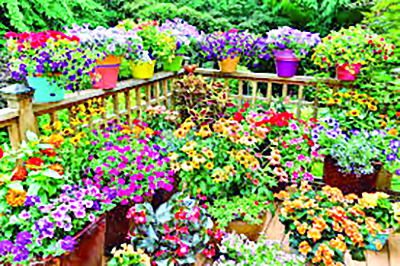Tom Rieman, Special to Bartlett Express

April 15th is the historical last frost date for Memphis. This means that it is now safe to plant annuals without the risk of having them damaged or killed by frost. This is also when our local nonprofits that focus on horticulture have their spring plant sales. They are great resources for rare and unusual plants that are typically not available at big box stores or even our locally owned nurseries.
When you bring home your treasurers you may intend to create some beautiful displays in pots to decorate your patios, entryways and gardens. You will gather your pots and plants and all you need now is some container soil. This is where you will need to make some wise choices to assure that you will have gardening success in the coming year.
The purpose of your container soil is to have a medium that will anchor plant roots and hold water yet drain well. You may be tempted to just dig some soil from your garden to fill your pot. This soil is a mixture of very small pieces of rock of varying size (sand, silt and clay) here in Memphis it would be mostly clay. It also contains biological material (plants, animals or microbes) at different stages of life or decay. Our native soil is not good to use in your pots as it does not drain well. You will be doing yourself a favor by purchasing a high quality potting mix and paying a bit of a premium over the cheaper alternatives.
Soilless Mix – Container mixes, often referred as soilless potting mix, typically are a mixture of some of the following ingredients; peat moss, coir, shredded bark, perlite and vermiculite. They are sterile, and have little nutrient value unless the mix also contains a slow release chemical fertilizer. Organic potting soils contain similar ingredients but will generally include compost as a major component.
Soil Mix / Garden Mix – These blends are more economical than the soilless mix and contain topsoil, sand, silt or clay and typically have a large amount of shredded wood or bark. Some may also contain compost. This is not a good choice for your pots. It is intended to be used for raised beds rather than as a potting medium.
Last year’s potting mix – The good news is that it is fine to reuse the potting mix you used last year. Potting mediums do not wear out or go bad. Over the course of the year it will have broken down and the particles are smaller. As a result it will have shrunk down in the pot. Rather than just top it up, dump it out and mix it well with a new potting mix then refill your pot.
After purchasing your plants and a nice container to put them in it is tempting to try to save a little by cutting back on potting mix. You will have learned from friends and social media that you can improve drainage by filling the bottom of your pot with pebbles. In large pots you can save money on potting soil and make the containers lighter by putting empty soda bottles, old tennis balls or packing peanuts in the bottom of a container.
Even Jason Reeves at UT Extension makes the second of these recommendations. Bless their hearts, they mean well but this may not be the best advice for your plants.
Let’s look at drainage. Water stops moving downward if it hits a layer of significantly different particles. Think of a sponge that is saturated. If you lift it up some water drains but the sponge is still saturated with water even though there is nothing below it. If you set the sponge on a layer of pebbles there would not be any additional drainage.
When we water a pot, a soil particle will absorb the maximum amount of available water it is able to hold before any water can move to the next particle. How much water it holds is determined by the composition of the soil materials. When we have thoroughly watered the pot it will drain to its “pot capacity” or the maximum amount of water the pot of soil can hold. The capillary action of the soil particles to hold onto water is in equilibrium with the forces of gravity that want to drain it away. Regardless of the soil composition the bottom of the pot will be saturated. That is the spaces between soil particles will hold only water. As you move upward in the pot the voids between the soil particles will have less and less water and more and more air. If you look at two pot of the same diameter but one is two feet tall and one is one foot tall the short pot will have the same degree of saturation as the bottom half of the tall pot.
Think again of that saturated sponge. If we turn it from flat to have its short side become vertical it will drain additional water but the bottom of the sponge will still be saturated. Now turn it so the long side is vertical. Again the sponge will drain but the bottom remains just as saturated as before. As we move upward toward the top, the sponge holds less water and more air, but the bottom remains fully saturated.
We think of plants as generating oxygen, which they of course do. But we sometimes forget that plant roots are like our lungs need to take in oxygen and they give off carbon dioxide. If there is no oxygen in the voids between the soil particles the roots will drown. We call this condition root rot. Dead roots cannot take up moisture or nutrients and our plants begin to die.
To make room for pebbles or fillers in the bottom of the pot we have to remove soil from the top of the pot. We are in effect making it a shorter pot. By doing this we are moving the wettest soil up into the root zone of our plants. Using pebbles or fillers in the bottom of our pots does not improve drainage, in fact, it does the opposite. It is like a sponge when it is lying flat.
In defense of Jason Reeves he is using filler in pots that are so large he can sit down inside of them with just his eyes peeking out the top and he is only planting annuals in these pots so even with a bit of filler the root zone of the plants he is planting are well above saturated soils. Jason does not recommend this technique for larger woody perennial plants that need to be planted in a large pot. The large perennials have deeper roots and require more soil. Additionally you need the added weight of the soil to help stabilize the planted pot against winds.
If you want to save some money and be certain of what you have in your potting medium you can make your own. This is only worth the effort if you have a lot of pots.

To these blends you can consider adding 10 percent of our clay soil after sifting it through a ¼ inch screen. This will help hold nutrients and moisture and help to prevent the potting mix from shrinking away from the side of the pot should it get too dry.
One final note. Be sure to raise your pot off of the ground using pot feet or bricks. This will assure that your pot can drain freely through their drain holes. A pot directly on concrete can result in staining, on a wooden deck it can lead to rotting. If it is in a garden bed it needs to be raised to keep roots from growing down through the hole and plugging it and cutting off the drainage. Alternatively in the garden if you want it to appear that it has been set on the soil. Dig a hole under the pot and use bricks to support the pot at soil level leaving a large void under the drainage holes.
APRIL Gardening Activities
Plant: Roses (no later than April 15) Buy azaleas while in bloom so you will know the bloom color. After April 15 plant annuals and warm weather vegetables, caladiums, and container plants. You can direct seed easy-to-grow flowering annuals and vegetables.
Lawn Care: Spot control weeds with herbicides. Overseed any thin fescue lawn by end of month
Fertilize: Spring blooming shrubs after blooming.
Prune: Cut back any woody perennials that may need it, like rosemary, rue, lavender, Santolina and Artemisia. Prune flowering shrubs as soon as they finish blooming.
Other: Inspect plants for insect damage and fungal disease and treat as needed. Late in the month move houseplants outside. Apply soil drench of imidacloprid to Crepe Myrtles attacked by bark scale last year.
April is also the month for plant sales. Check out these upcoming plant sales for grasses and other unusual plants.
Lichterman Nature Center April 12 & 13
Dixon Gallery and Gardens April 18 – 20
Memphis Botanic Garden April 19 & 20
Bartlett City Beautiful April 26 – 28




